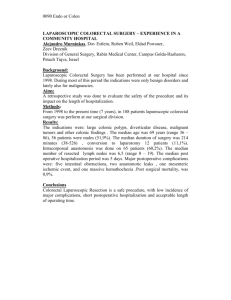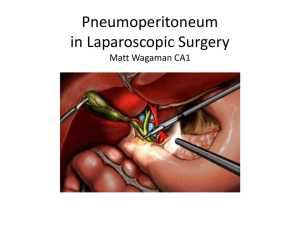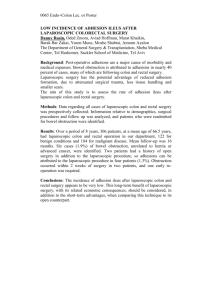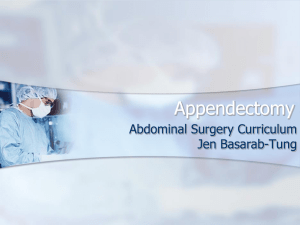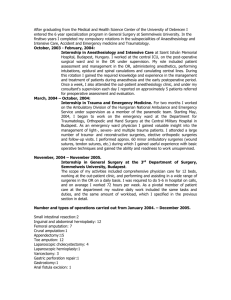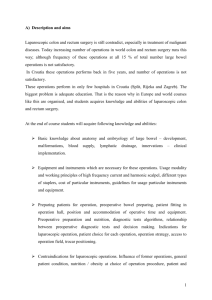Lectures C5-6 – Minimally Invasive Surgery
advertisement
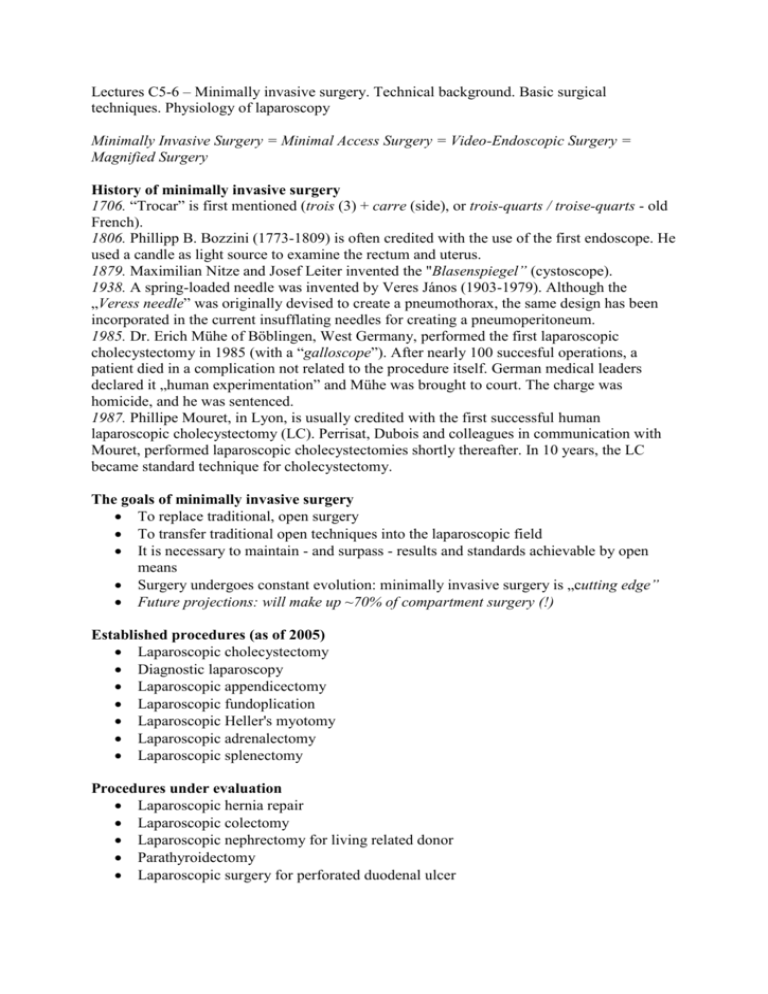
Lectures C5-6 – Minimally invasive surgery. Technical background. Basic surgical techniques. Physiology of laparoscopy Minimally Invasive Surgery = Minimal Access Surgery = Video-Endoscopic Surgery = Magnified Surgery History of minimally invasive surgery 1706. “Trocar” is first mentioned (trois (3) + carre (side), or trois-quarts / troise-quarts - old French). 1806. Phillipp B. Bozzini (1773-1809) is often credited with the use of the first endoscope. He used a candle as light source to examine the rectum and uterus. 1879. Maximilian Nitze and Josef Leiter invented the "Blasenspiegel” (cystoscope). 1938. A spring-loaded needle was invented by Veres János (1903-1979). Although the „Veress needle” was originally devised to create a pneumothorax, the same design has been incorporated in the current insufflating needles for creating a pneumoperitoneum. 1985. Dr. Erich Mühe of Böblingen, West Germany, performed the first laparoscopic cholecystectomy in 1985 (with a “galloscope”). After nearly 100 succesful operations, a patient died in a complication not related to the procedure itself. German medical leaders declared it „human experimentation” and Mühe was brought to court. The charge was homicide, and he was sentenced. 1987. Phillipe Mouret, in Lyon, is usually credited with the first successful human laparoscopic cholecystectomy (LC). Perrisat, Dubois and colleagues in communication with Mouret, performed laparoscopic cholecystectomies shortly thereafter. In 10 years, the LC became standard technique for cholecystectomy. The goals of minimally invasive surgery To replace traditional, open surgery To transfer traditional open techniques into the laparoscopic field It is necessary to maintain - and surpass - results and standards achievable by open means Surgery undergoes constant evolution: minimally invasive surgery is „cutting edge” Future projections: will make up ~70% of compartment surgery (!) Established procedures (as of 2005) Laparoscopic cholecystectomy Diagnostic laparoscopy Laparoscopic appendicectomy Laparoscopic fundoplication Laparoscopic Heller's myotomy Laparoscopic adrenalectomy Laparoscopic splenectomy Procedures under evaluation Laparoscopic hernia repair Laparoscopic colectomy Laparoscopic nephrectomy for living related donor Parathyroidectomy Laparoscopic surgery for perforated duodenal ulcer Robotic surgery This is truly the cutting edge of surgery. Most common is adult cardiac procedures. The major benefits are in decreasing the “human factor”, like shaking of hands, hand-eye coordination problems, etc. • There are two main types of systems: Da Vinci and Zeus. • Da Vinci: better manipulators • Zeus: smaller instruments (3 mm) • Learning curve: first fundoplication took 4.5 hrs surgical time, now 1.5 hrs, with corresponding decreases in setup time. Foetoscopic surgery In-utero procedures done laparoscopically. Some of the procedures being performed include: • Bladder decompression • Radio ablation of abnormal vessels in twin gestations • Laparoscopic division of amniotic bands and drainage of hydrothorax Advantage of minimal access surgery Diagnostic + therapeutic procedures Better cosmesis. Fewer postoperative complications, hernias / infections Fewer postoperative adhesions. Main causes fewer hemorrhagic complications; less peritoneal dehydration; lower degree of tissue trauma; lower amount of foreign material (sutures). Shorter postoperative recovery. Main causes: less tissue trauma; stress in general is lower less postoperative pain Patients are able to return to their normal activities faster (6 days). Mechanism of wound healing is identical (!) – recovery depends on: o indication (cause of illness) o healing time of incisions/ports and insults of organs and abdominal wall, stress caused by general anesthesia peritoneal damage Faster recovery Laparoscopy: 7-14 days Laparotomy: 4-6 weeks Economical advantage decreased hospital stay will decrease surgical costs by 50-60% post. op. recovery time after endoscopic surgery can be shortened by 4-6x Disadvantages of minimal access surgery Lack of tactile feedback Increased technical expertise required Possible longer duration of surgery Increased risk of iatrogenic injuries Difficult removal of bulky organs More expensive Non-corrigated coagulation problems The laparoscope The term originates from „lapar” (Gr) = "the soft parts of the body between the rib margins and hips” – loin; skopein (Gr) = "to see/ view / examine. The laparoscopic tower Parts (in general): 1. monitor (screen), 2. video system (control unit, etc), 3. light source, 4. insufflator ± carbon dioxide cylinder, 5. suction and irrigation, 6. electrocautery device, 7. data storage system. The endoscope and camera are attached to the units of the tower with cables. Endoscopes - background Traditional system. Diameter of lens < length of endoscope. Distance between lenses is large, the light travels through long distances between lenses, light absorbance 9095% → image is dark. B. Hopkins optics (1966)- rod lens system. Space between lenses is filled with glass and air. Light transfer ↑ loss/absorbance ↓ (approx. 70%) → much better image quality Endoscopes – optical characteristics a. View Angle between the of objective and other lenses within the endoscope: determines the direction of the view. In operating endoscopes: 0°-30° - 0°- endoscope: the amount of light forwarded to the ocular is the highest. b. Field Between the borders of the image - „how wide is the view" c. Focus Increasing / decreasing the magnification either by turning the laparoscope's zooming ring, or by advancing laparoscope toward or withdrawing it from the targeted area. The depth of field of the laparoscope is measured in centimeters: the closer the objective is to the tissue, the shallower the depth of field. d. Light loss Hopkins endoscopes > 12 lenses. Only 20%- of the light leaves the ocular part of the endoscope. Light guide The illumination is transmitted to the laparoscope via a flexible fiberoptic light guide (180250 cm long, 0.5-1.0 cm OD). This illumination is essentially cold - most of the lamp heat is not transferred to the laparoscope. Light source • Working in a closed environment requires a source of external illumination. • Currently the 150-300 W fan-cooled xenon light source is used to provide colorcorrected light for extended periods of time without overheating. The video system The coupler between the laparoscope and the video camera is equipped with a focusing and zooming ring. Camera head: attached to the endoscope, receives the image and transfers to electric signals. The basis of laparoscopic cameras is the solid-state silicon computer chip the CCD (charge-coupled device). (Willard Boyle and George Smith, 1969, Bell Laboratory). Control unit: receives the signals of the camera head, converting the optical image into the initial video signal. The video sensor (head) can contain 1- or 3-chip sensor. The 1-chip sensor is economical, whereas the 3-chip involves an improved image quality. One-chip camera: single CCD sensor, which is responsible for converting the optical image into the initial video signal that is processed and displayed on the video monitor. The 3-chip camera has separate red, green and blue sensors for improved color definition, and a RGB connection to the monitor is recommended. Physiology of laparoscopy. Pneumoperitoneum - background First used in gynecology; air by hand. Insufflator: closed system for gas insufflation; pressurecontrolled device for creating and maintaining pneumoperitoneum. In addition to the delivery of gas, insufflators have the ability to control the maximal flow rate of the gas and the pressure of gas (< 15 mmHg) within the abdomen. Intraabdominal pressure (IAP) Adult patients: IAP < 15 mmHg Pediatrics: < 6 mmHg Pneumoperitoneum - technique Closed technique, Veress needle Open: Hasson technique (1971). Open technique: morbidity is less, BUT: the type of complications is the same (!) Physiology of laparoscopy. Example: laparoscopic cholecystectomy o CO2 at 15 mmHg in healthy patients o Overall: decrease CO and SV, increase MAP and SVR o No adverse events Advantages o a large, dome-like space is created → displacement of viscera → enabling the surgeon to see and move about the instruments; o The gas pressure of an established pneumoperitoneum is above the surrounding atmospheric pressure. o P venous < IAP → control of capillary and venous bleeding Ideal gas Colorless Biologically inert Absorbed harmlessly and rapidly into the bloodstream Does not support combustion Cheap High flow (> 16 l/min) CO2 Not inert, but widely used Cheap Easily transported Alternatives: helium, nitrous oxide Warm and humidify the gas to prevent hypothermia and desiccation Insufflator reading/monitor o Gas composition o IAP o Gas volume and flow rate o Alarm system that sounds when the pressure exceeds the preset level o Automatic exsufflation o Gas: Cylinder (50-200 bar pressure) Central unit (3.5-5 bar). o Inlet valve for connection to a gas tank and an outlet port from which sterile plastic tubing is passed to the patient and is used to deliver the gas. o IAP = average 12 mmHg (1 bar=760 mmHg) → reduction to 50-80 mmHg o Lowest gas flow (1 l/min) during the initial phase of pneumoperitoneum (introduction of Veress needle). o IAP < 12-15 mmHg → venous dysfunction. o IAP > 12-15 Hgmm = CI ↓, gas exchange problems o Continuously high IAP → organ damage Hemodynamic complications o Can die from tension pneumoperitoneum = equivalent to a intraabdominal compartment syndrome o Decrease in organ function due to decreased microcirculation o Tension pneumoperitoneum: IAP > 40 mmHg, very restricted CO, potentiated by hypovolemia, dysrhythmias (due to hypercapnia, vagal stimulation) o Decreased femoral vein pressure → stasis Circulation Venous outflow (preload) ↓ CO ↓ HR ↑ MAP ↑ TPR (afterload) ↑ PVR ↑ Hemodynamic changes are more significant in reverse Trendelenburg position AND incidence and risk of deep venous thrombosis is increased. Trendelenburg / anti-Trendelenburg position: only when the condition is stable, AFTER the pneumoperitoneum. ABG o CO2 in systemic circulation: hypercapnia + respiratory acidosis. o Insufflation: PaCO2 = 8-10 mmHg rise together with a decrease in pH. o Equilibration:15-20 min after pneumoperitoneum. Respiratory effects o IAP ↑: intrathoracal pressure ↓ lung compliance ↑ airway resistance (restrictive syndrome). o Compression of lower lung lobes (cause: intraabdominal pressure + anesthesia-induced diaphragm relaxation) → lung volumen ↓, dead space ↑ (Trendelenburg position will enhance these effects). Effect likely irrelevant in healthy patients o Possibility to improve gas exchange: positive end expiratory pressure (PEEP) Kidneys (excretion) o IAP <15 mmHg: consequences are clinically not significant. o Higher IAP: decreased kidney perfusion, glomerular fiiltration rate, UO o Direct pressure on kidney parenchyma, renal arteries and veins: renal function will decrease linearly with pressure o Oliguria: decreased UO seen universally (animal and human studies) o Can have anuria: depends on degree of IAP and OR time. Increased in patients with CVS, hemodynamic, and renal dysfunction. Reversible (no renal failure reported). Watch for fluid overload. Oliguria etiologies o o o o Likely multifactorial Ureteral obstruction Decrease in CO and renal blood flow Renovascular or parenchymal compression Compression is associated with decreased U/O Mediated by increased renin secretion May also directly impact RBF, capillary flow, and tubular flow → decrease in GFR → decreased U/O o Central venous congestion - neuroendocrine mechanism Hormonal changes Renin Increases with increased IAP; relative cortical ischemia; redistribution of RBF from cortex to medulla • ACE-I does not prevent oliguria • Stimulation of the neurohormonal system is independent from the quality of gases • Vasopressin + renin-aldosteron-angiotensin = vasoconstriction. Endothelin • Potent vasoconstrictor • Increased in renal vein in pneumoperitoneum • May maintain MAP despite decreased CO with laparoscopy Liver function o Hepatic and portal circulation progressively decreasing: increased liver enzymes in plasma. Microcirculation o Mechanical compression of mesenteric vessels, decreased splanchnic microcirculation. Recommendations • Use lowest possible insufflation pressures • Maximize fluid status preoperatively • Avoid overhydration interoperatively in response to oliguria • Consider preop. pulmonary and cardiac status • Most changes reverse quickly postop. Complications of pneumoperitoneum 20-40% of all complications is related to pneumoperitoneum. Rare (in <1% of all laparoscopy) but severe. o Vessel injury (0.04-0.05%) less frequent than organ damage but potentially more severe (mortality: 8-17%). Most common: epigastric vessels, vessels of greater omentum. Large veins, arteries can be punctured during the insertion of the Veress needle or first trocar (aorta, vena cava, vena portae, iliaca, etc.). Rare but 50% mortality. o Organ injuries: small bowel, large bowel, liver. If untreated (in 24h) severe septic complication (0.06-0.14% incidence with mortality >20%). o Air emboli (<0.6%) rare but potentially lethal. Most common: lung. Rare: coronaris, brain Air emboli - main mechanisms of air embolism: o During the induction of pneumoperitoneum direct puncture of vessels with Veress needle or first trocar; o Parenchymal organ (e.g. liver) intraoperative vessel damage; o Rare: helium with high intraabdominal pressure (>20 mmHg). Gases o CO2: danger of emboli is negligible (2 ml/kg/min CO2 iv (experimental) did not cause lethal complications. o N2O: if pneumoperitoneum is not kept up with regular filling N2O gas concentration (anesthesiology!) will increase in the abdomen → increased risk of embolizaton. o He: poor tolerance - 0.1 ml/kg/min causes severe cardiac side-effects. Prevention of air emboli o Safe trocar use o Intraabdominal pressure control o Soluble gases Diagnosis o Trans-oesophageal Doppler UH (no routine use in laparoscopic surgery); o Capnography (!): end-tidal CO2 ↓(consequence of decreasing CO + increasing dead space). o Parallel decrease in PaO2: highly suspicious. o ECG changes: late, large embolization (!). Therapy o Stop insufflation, exsufflate pneumoperitoneum; o Left sided Trendelenburg position: decreases embolization from the right heart to pulmorary circulation; o N2O stop + 100% O2 - hyperventilation (goals: decrease dead space, increase excretion of CO2 through lungs, correction of hypoxia); o CV catheter into pulmonary artery → gas aspiration. Remarks Elimination of CO2 in lungs is promoted by the large cc gradient. Signs are usually quickly improving and the condition is reversible without treatment. Subcutaneus emphysema Cause o CO2 under pressure dissects tissues. o Accidental or intentional (extraperitoneal surgery). o Increasing CO2 absorption → PaCO2 ↑ (proportional to the severity of emphysema). o Suspicious: PaCO2 ↑ during the first 20 min of pneumoperitoneum. Therapy o RR ↑ = stabilization, stop insufflation to get rid of CO2. Pneumothorax Cause o P intraabdominal ↑ = opening of embrional peritoneo-pleural channels → „spontaneos” Ptx. o Nearly always in case of diaphragmatic preparations (classical: fundoplication). Consequences o Increased airway pressure o PaCO2 ↑ o PaO2 ↓ o O2 saturation ↑ o Pulmonary resistence ↑ o CO ↓, compensatory HR ↑ Treatment of pneumothorax o PEEP (5 Watercm) = lung reinflation + CO2 ex o N2O stops, FiO2 ↑, P intraabdominal ↓. o Thoracocentesis: usually not necessary, CO2 will be absorbed in approx. 30 min and Ptx will cease. Important: Discern CO2 + PTX and rupture of alveoli (emphysema – which is a consequence of PEEP). Emphysemic rupture: PEEP will aggravate signs → PTX can not be eliminated „spontaneously”, therapy: chest tube (!) Increased intraabdominal pressure o „Surgical”: circulatory and respiratory changes, large individual differences in tolerance. Significant rise: increased risk of complications caused by diffusible gases (air embolus, subcutaneous emphysema). o „Anaesthesiology”: insufficient depth of anaesthesia/narcosis/muscle relaxation → < 20 mmHg pressure + strong contraction of abdominal muscles. o Quick intraabdominal volume load (e.g. suction/irrigation) or simultaneous use of other gases (e.g. argon coagulation). „Laparoscopic” pain o The character of this pain differs from open laparotomy. o Laparotomy/open surgery: dominating abdominal pain o Laparoscopic pain: deep visceral pain (this is covered by abdominal pain during open surgery) o Characteristics: pain in shoulder, shoulder blade (cause: pneumoperitoneum-induced diaphragm tension + CO2 –induced acidic irritation Therapy o CO2 complete removal o irrigation with warm saline at the end of the procedure o local anesthetic solutions (e.g. bupivacaine): subdiaphragmatic use Diathermy o Bipolar (insulated) system: places the tissue between two electrodes, so the current passes from one electrode to the other through the interposed tissue. The technology of precision coagulation: peripheral vascular and microsurgery o Monopolar (grounded): the ground pad should have a surface area of approx. 50 cm2, placed over muscular tissue, and coated with a conductive gel to enhance conductance. Suction and irrigation o Quick removal of abdominal fluid is mandatory. o Irrigation + suction can not be separated → in most of the tools these functions are joined. o Central unit: electric pump with continuous 180 mmHg positive and 500 mmHg negative pressure. Fluids: warm isotonic solutions (saline) Large amounts of fluid o Treatment of generalized, acute infections; o Bile duct operations; o Hydro-dissection. Possibilities o Infusion sack + pressure – e.g. cuff of manometer. Infusion set is attached to a suction/irrigation unit. Advantage: simple. Disadvantage: pressure is usually too low, fluid volume is restricted. o Pneumatic (air) devices: single use sets using central compressed air systems. Advantage: relatively cheap, pressure is adequate. o Peristaltic pumps with adjustable roller pump o Complete, single-use sets. Irrigation unit contains a pressure-generating electric pump „Open surgery” in closed environment Hand-Assisted Laparoscopic Surgery (HALS): clinical and visual benefits of laparoscopy + tactility and control of open surgery. Pneumoperitoneum is kept up by non-adhesive sealing: the surgeon reaches trough a valve with long gloved hand and directly manipulates the tissue. The other hand is using laparoscopic instruments, viewing all this on the video display. Access o Veress needle: blunt obturator retracts on contact with solid tissue to reveal a cutting tip. o Once the peritoneal cavity is entered, gas may be instilled through the hollow shaft of the needle. o The needle is then removed, and a trocar/cannula is inserted through the same site. This method is called: blind or closed technique Trocar Once the pneumoperitoneum is established, a cannula or port must be inserted to allow the passage of the laparoscope and operating instruments into the abdomen. o Trocar: a sharply pointed shaft, usually with a 3-sided point. o A trocar may be used within a cannula (tube) to be inserted into a body cavity. o 3 main parts 1. trocar 2. cannula (working channel); 3. trocar valve o In practice, the term „trocar” is commonly used to describe the whole trocar-cannula apparatus. o As a safety feature, most disposable cannulas are equipped with a plastic sleeve, which automatically covers the cutting obturator once it has pierced the abdominal wall. o In order to prevent gas leaking from the port sites, the trocar incorporates a valve. This allows the insertion of instruments without the escape of gas. Hand instrumentation o Special instrumentation. o Remote and closed surgical environment o The instruments jaws located within the closed environment, the handle external. o Length: 10-50 cm (most commonly 30 cm), depending on the distance of target tissue from the point of access. o Disposable (single-use), reusable (on a long-term basis), or "resposable" (features of both disposable and reusable) instruments. Laparoscopic cholecystectomy One of the most common laparoscopic procedures; in 2006: standard procedure for cholelithiasis and cholecystitis. Contraindications o High risk for general anaesthesia o Morbid obesity o Signs of gallbladder perforation (abscess, peritonitis, or fistula) o Giant gallstones or suspected malignancy o End-stage liver disease with portal hypertension and severe coagulopathy Laparoscopic appendectomy First performed in 1987, successful in 90-94% of attempts. Advantages o o o o increased cosmesis decrease in the postoperative wound-infection rate. shortened convalescent period shortened hospital stays. Disadvantages o increased cost o operating time approx. 20 min longer than that of open appendectomy. Contraindications o significant intra-abdominal adhesions o pregnancy beyond the first trimester In vitro training o Instrument use/suturing in the endoscopic field is based on microsurgical techniques. o Intracorporeal suturing in the minimal access surgery field is based on precision techniques developed by Alexis Carrel (1873-1944), Nobel laureate (1912) and Charles Claude Guthrie (1880-1963). o First step: practice is a trainer box with ports for instruments and the scope. In a pelvi-trainer („box-trainer”, „MAT-trainer”) one should practice on the same quality optical-video-monitor setup as used in the operating room. o Greater precision and improved results are possible with laparoscopic techniques - added benefit of magnification and better visualization
